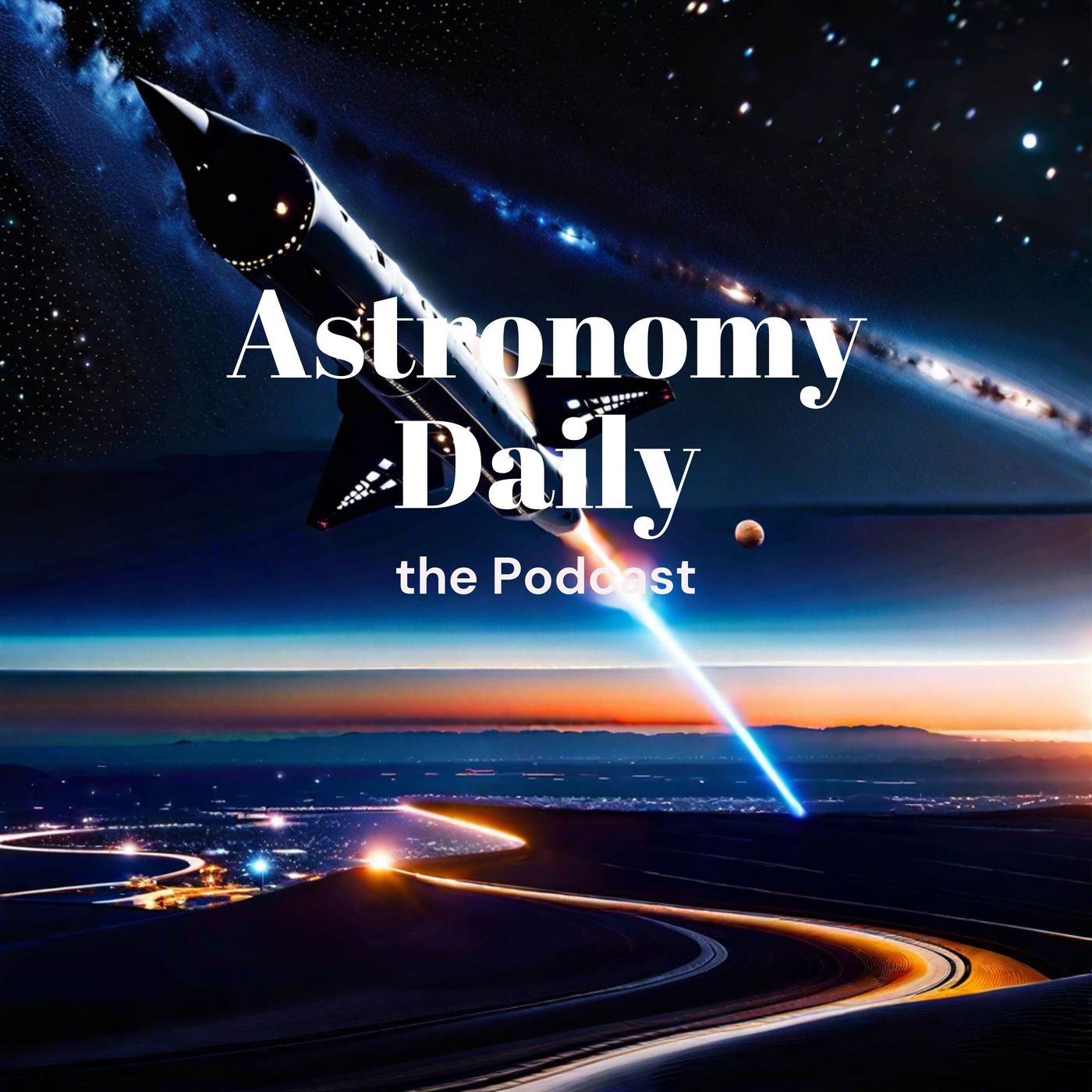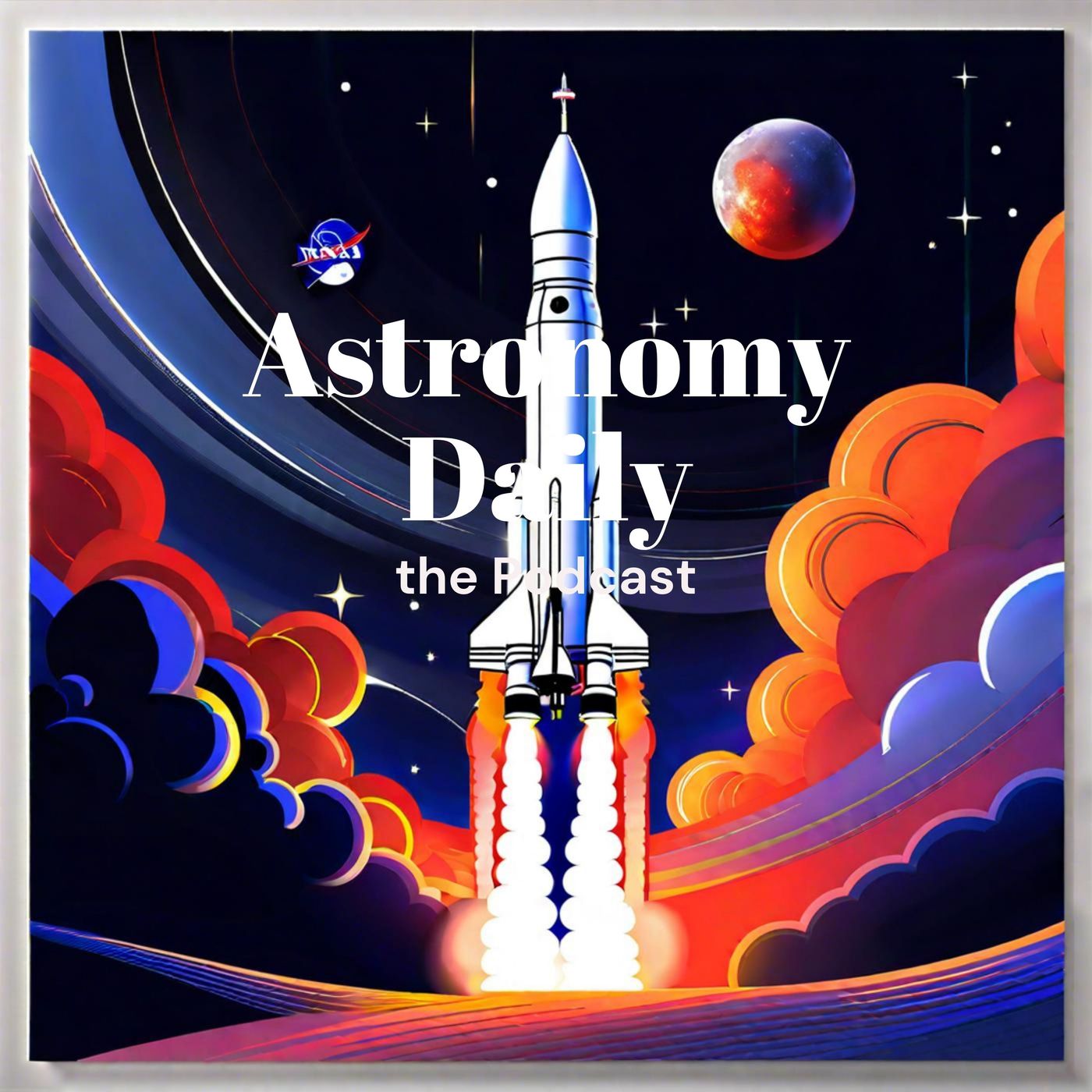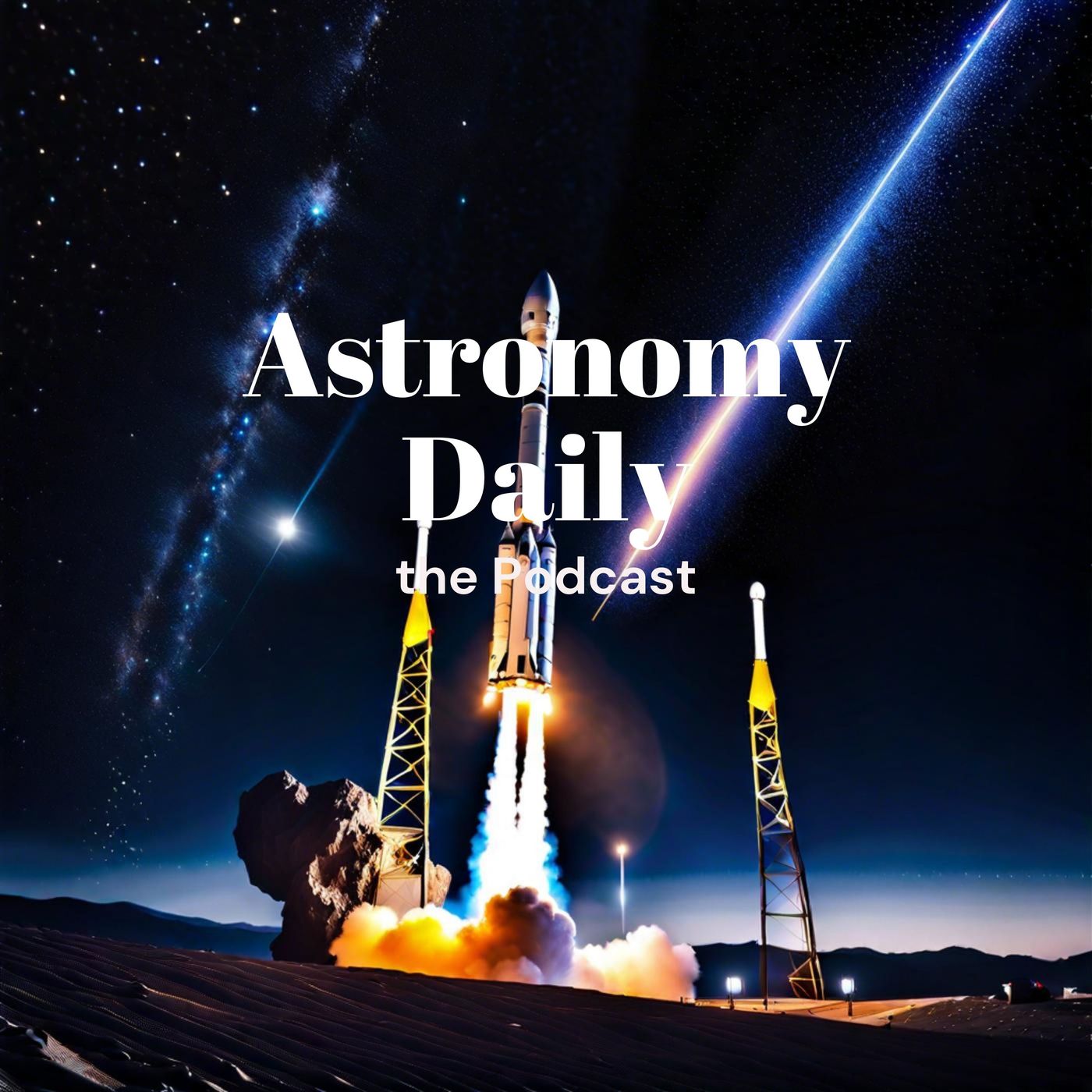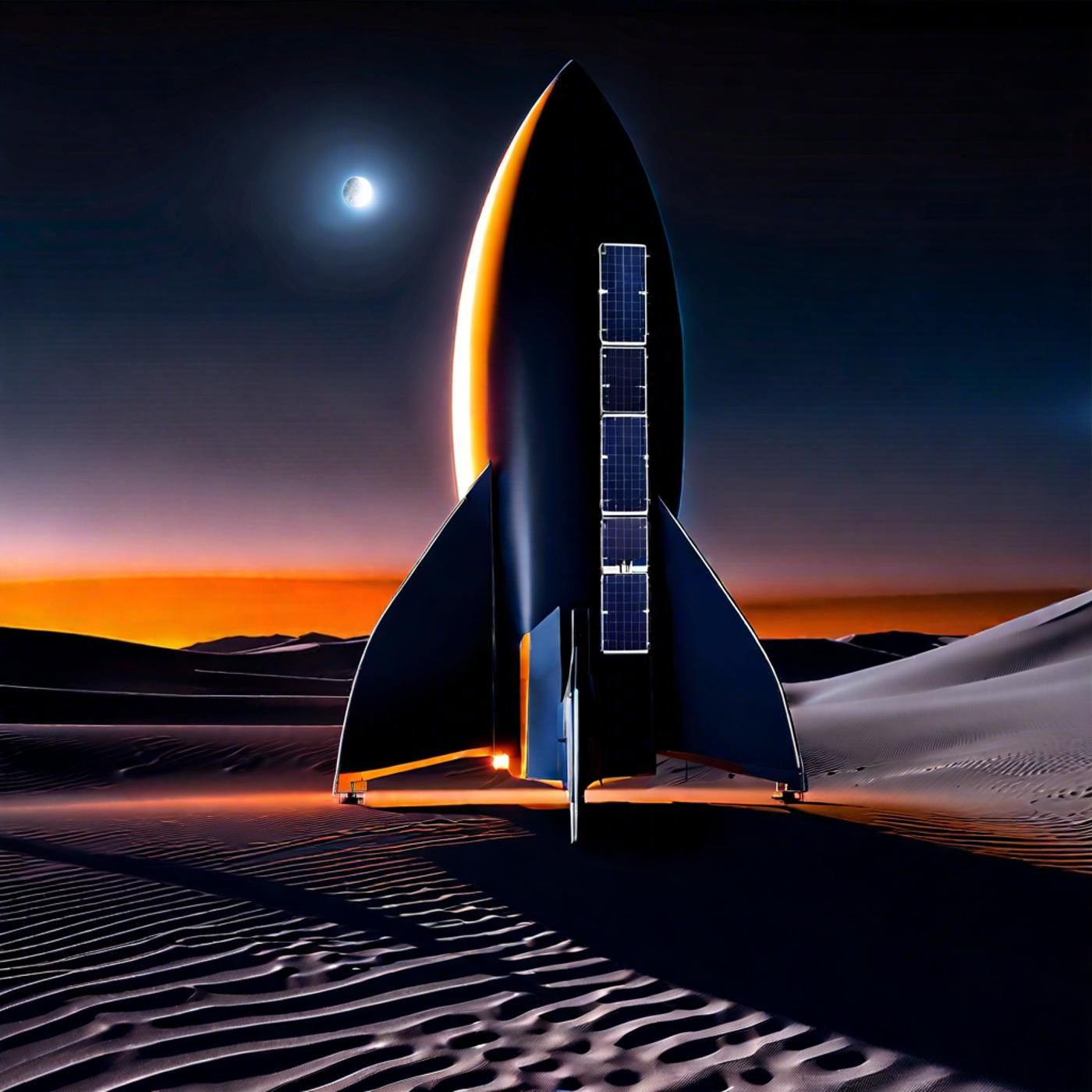S03E137: Jupiter's Storms, Moon's Fiery Past, and Extraterrestrial Cuisine
AstroDailyPod - The Podcast: 26 August 2024
Welcome back to another episode of Astronomy Daily the Podcast with your host, Steve Dunkley and Hallie. Today, we've got a fascinating mix of stories that will take you from the depths of Jupiter's Great...
AstroDailyPod - The Podcast: 26 August 2024
Welcome back to another episode of Astronomy Daily the Podcast with your host, Steve Dunkley and Hallie. Today, we've got a fascinating mix of stories that will take you from the depths of Jupiter's Great Red Spot to the future of SpaceTime colonies. Buckle up for an intriguing journey through space and time.
Highlights:
- The Great Red Spot: Discover the latest findings on Jupiter's Great Red Spot, its history, and the mysteries surrounding this massive atmospheric structure.
- - The Moon's Magma Ocean: Explore new data from India's Chandrayaan-3 mission supporting the theory that the Moon was once covered by a molten rock ocean.
- - Space Food Competition: Learn about NASA's challenge to develop deep-space food solutions, featuring innovative technologies and surprising ingredients.
- - Polaris Dawn Mission: Get the inside scoop on the Polaris Dawn mission, aiming to set new records with its private spacewalk and high-altitude flight.
- - Cost-Effective Europa Missions: Dive into the details of a proposed Europa mission that could drastically reduce costs using advanced technologies.
- - Future Space Colonies: Envision the complex relationships that might develop between Earth and future SpaceTime colonies, from economic dependencies to cultural differences.
- For more Space and Astronomy news, be sure to visit our website at astronomydaily.io. There you can sign up for our free daily newsletter, read insightful blog posts, and catch up on all the latest space and astronomy news with our constantly updating newsfeed.
- Don't forget to listen to all our previous episodes as well. You can also follow us on social media. Just search for AstroDailyPod on facebook, X, YouTubeMusic, and TikTok to stay connected with our community and never miss an update.
- Until next time, keep your eyes on the stars.
- Sponsor Links:
- Nordpass
- NordVPN
- Malwarebytes
- Proton Mail
bitesz.com
Become a supporter of this podcast: https://www.spreaker.com/podcast/astronomy-daily-the-podcast--5648921/support.
Steve Dunkley: Hello again. It's Steve here for another episode of Astronomy AstroDailyPod. It's the 26 August 2024 with your host, Steve Dunkley. Oh, and welcome back to Astronomy AstroDailyPod. Thanks for joining us again today. We've got a mixed bag for you. We might as well start with a big one. We're going to have a look at something huge, a closer look at the great red spot. Now, there's been a study and they've found out some interesting things about the great red spot and its history. We're also going to be looking at the moon and the moon's history. There's possibility that it was once covered by magma and there's been a huge competition in the United States, turning and we're talking about space food and one of the features of space food, well, it's got me intrigued and you'll hear about that later. I don't know if you've heard about Polaris Dawn. Polaris dawn is going to set a new record. Let's see if they can pull this one off. It's looking very good, but it's also famous for another reason and we'll look at that and, you know, one of the big features or one of the big reasons why space missions are, they either get scrubbed or they go ahead is the cost and we'll be look at the money, especially in one particular type, of mission. So we'll look at the European lander and there's a great story about space colonies and the relationships that may or may not emerge between Earth, and space colonies in the future. So that's going to be interesting. So over to Hallie. Take it away, Hallie.
Hallie: Thanks, Steve.
The great red spot is easily recognisable due to its reddish hue
Here's a fascinating story about one of the solar system's greatest features. Jupiters great ReD SPOt stands out as one of the most iconic features in the solar system. This massive atmospheric structure, currently spanning a diameter equal to that of Earth, is easily recognisable due to its striking reddish hue, which contrasts sharply with Jupiters pale cloud tops. Even small telescopes can capture its distinct appearance. The GREaT ReD SPot is a gigantic anticyclonic vortex with winds reaching speeds of 450 kilometres h along its outer edges. It holds the title of the largest and longest lasting vortex in the atmospheres of any planet in our solar system. However, the exact age of the great red spot is still debated and the processes behind its formation remain a mystery. Speculation about the origin of the great red spot dates back to the first telescopic observations made by the astronomer Giovanni Domenico Cassini. Who in 1665 discovered a dark oval at the same latitude as the great red spot and named it the permanent spot, since it was observed by him and other astronomers until 1713. In a recent study, authors first analysed the evolution of its size over time, its structure and the movements of both meteorological formations, the former permanent spot and the great red spot. To do so, they used historical sources dating back to the mid 17th century, shortly after the invention of the telescope. From the measurements of sizes and movements, we deduce that it is highly unlikely that the current great red spot was the permanent observed by G. D. Cassini. The permanent spot probably disappeared sometime between the mid 18th and 19th centuries, in which case we can say that the longevity of the red spot now exceeds 190 years at least, explained Augustin Sanchez Lavega, professor of physics at the UPV Ehu and who led this research. The red spot, which in 1879 was 39,000 kilometres in size at its longest axis, has been shrinking to about the current 14,000 kilometres and simultaneously becoming more rounded. What is more, since the 1970s, several space missions have studied this meteorological phenomenon closely. Recently, various instruments on board the Juno mission in orbit around Jupiter have shown that the great red spot is shallow and thin when compared to its horizontal dimension. As vertically it is about 500 kilometres long, explained Sanchez la Vega. Future research will aim to try and reproduce the shrinkage of the great red spot over time in order to find out in greater detail the physical mechanisms underlying its sustainability over time. Data from Indias recent Chandrayaan three mission supports the idea that an ocean of molten rock once covered the moon. On August 23, 2023, a lander called Vikrum successfully touched down on the lunar surface. Controllers then deployed a rover called pregionental, which had been stowed on Vikram to explore the landing site. The location where Vikram touched down was further south than any other landing craft had previously been on the moon. It gave scientists an insight into the geology of the moon that had not yet been sampled. Preghyans measurements found that the particular mix of chemical elements in the lunar soil, or regolith, surrounding the lander was relatively uniform. This regolith was primarily made up of a white rock type called pharaohen anorthosite. The scientists say the chemical composition of the lunar south pole regolith is intermediate between those of samples from two locations in the moon's equatorial region, those collected by astronauts on the US Apollo 16 flight in 1972, and those returned to Earth by the robotic Luna 20 mission flown by the Soviet Union the same year. The broad similarity in the chemical compositions of all these samples, despite the fact they came from very distant geographical locations on the moon, supports the idea that a single magma ocean covered the moon early in its history. The moon is thought to have formed when a Mars sized planet collided with Earth, ejecting rock that subsequently coalesced to form our planets only satellite. The lunar magma ocean is thought to have been present from its formation to tens or hundreds of millions of years afterwards. The cooling and crystallisation of this magma ocean eventually led to the farrow and anorthosite rocks that make up the moons crustace. NASA challenged the public to make deep space food. Its all about engaging with creative people to find solutions for providing better food for space missions. And heres what happened. The challenge began in 2021 and to date has included more than 300 teams from 32 countries. The endeavour is also split between NASA and the Canadian Space Agency. Talk about a spaceborne food fight, right Steve?
Steve Dunkley: That sounds like fun to me, Hallie.
Hallie: Winners were selected during the first two phases of the competition, and the final phase three began in September 2023. Four american teams were awarded $50,000 each and invited to compete in the third and final phase of the competition, during which they had to construct a full scale model of their food production system and demonstrate how it works. Phase three was hosted by the Methuselah foundation and Ohio State University. For two months, the teams tested and demonstrated their technology in Columbus, Ohio at the universitys campus. During this period, important milestones had to be passed, including palatability, safety, sensory testing, and harvesting volumes. Each teen had a group of Ohio state students known as simunauts that were in charge of the process during the eight week period and collected information to present to a judging panel. Interstellar lab in Merritt Island, Florida, took home the grand prize of $750,000. Barbara Belvezzi and her Timms developed a small business that uses a combo of artificial intelligence, advanced equipment, and bioscience to create ingredients that are plant based and can be used in space as well as on earth through its growth system. The food production operation is self sustained, procuring microgreens, vegetables, and even the insects needed to produce micronutrients.
Steve Dunkley: Wait a minute, insects?
Hallie: That's what it says.
Steve Dunkley: Ooh. Okay then.
Hallie: Nolux, a team consisting of researchers from the University of California, Riverside, was a runner up that received $250,000 for its development of an artificial photosynthetic system that can produce plant and fungal based foods in the absence of biological photosynthesis. The other runner up who took home $250,000 was Jim Sears, the solo creator behind the standing for safe appliance. Tidy, efficient, and delicious sated device, Sears was able to generate different types of customizable food, including peach cobbler and pizza.
Steve Dunkley: Okay, that sounds more like it.
Hallie: I'll take your word for it, human. Each product is fire safe and includes a combination of in situ grown ingredients and those with an extended shelf life. Did you get that, Steve? Fire safe food.
Steve Dunkley: Yeah, I heard that.
Hallie: Maybe they've heard of your interesting cooking skills. Or lack thereof.
Steve Dunkley: Whoa. There's nothing wrong with my cooking, Hallie. Don't knock char grilled lasagna until you've tried it. Okay? Thank you for joining us for this Monday edition of Astronomy AstroDailyPod, where we offer just a few stories from the now famous astronomy daily newsletter, which you can receive in your email every day, just like Hallie and I do. And to do that, just visit our, URL, astronomydaily IO, and place your email address in the slot provided. Just like that, You've been receiving all the latest news about science, space science and astronomy from around the world as it's happening. And not only that, you can interact with us by visiting Astro DailyPod on X or at our new facebook page, which is, of course, astronomy daily on facebook. See you there. Astronomy daily with Steve and space space science and astronomy.
The Polaris dawn mission is scheduled to launch on August 27 from SpaceX
Two women astronauts will set a spaceflight record next week, if all goes according to plan. The Polaris dawn mission is scheduled to launch atop a SpaceX Falcon nine rocket no earlier than August 27. It aims to perform the first ever private spacewalk and to fly higher above the earth than any crewed spacecraft since the Apollo era. At about 1400 kilometres, that's 870 miles for you Americans. The mission is funded and commanded by billionaire Jared Isaacman, who also funded and commanded the private inspiration four orbital mission in 2021. Polaris Dawn's four person crew includes female mission specialists Sara Gillis and Anna Menon, both of whom are, SpaceX engineers, as well as male pilot Scott Kidpertit. The highest flying woman before Gilles and Menon was NASA astronaut Catherine Sullivan, who reached 380 miles, or 621 kilometres. And that was on STS 31 during the space shuttle programme. According to NASA and space statistics tracker, Jonathan McDowell of the Harvard Smithsonian Institute of Astrophysics, STS 30 one's extreme altitude was the result of its main goal, deploying the Hubble Space Telescope. As you might remember, it's a top tier space observatory, still active today thanks to the efforts of spacewalking astronauts on five different servicing missions. On board STS 31 were five astronauts, including Sullivan, who reached space just seven years after NASA flew its first woman astronaut, Sally Ride. And that was in June 1983. The five Hubble servicing missions, which flew between 1993 and 2009, reached lower altitudes than STS 31, while a few crewed missions ranged farther into space than Hubble's height. All of those missions were crewed by males. That's just a bit of a different take on missions. Instead of talking about the technology and the mission, directives, we're talking about genders. Interesting. Strange. True. You're listening to Astronomy daily, the podcast with your host Steve Dudley at Birmingham. As you might imagine, cost is a major driving factor in the development of space exploration missions. Any new technology or trick that could lower the cost of a mission makes it more appealing for mission planners. Therefore, much of NASA's research goes into those technologies that enable cheap emissions. For example, a few years ago, NASA's Institute for Advanced Concepts, that's NIAC, supported a project by Michael van Woelcom of Exoterra resource to develop a land emission mission that could support a sample return from Europa. Now let's have a look at what made that mission different from other Europa mission architectures. The nano icy moons propellant harvester nymph mission m relies on three main advancements for one significant result, a ah, ten times reduction in the overall mission cost. That reduced cost comes mainly from a single fact. The mission's weight has dropped below the threshold where it can be launched by an atlas V rather than the SLS, as similar missions would require. The mission cost estimated for an SLS launched Europa lander was around $5 billion, making it prohibitively expensive for NASA or any other agency without significant sacrifices to other missions. Exo Terrace estimates that by using several weight reducing technologies, they could bring the mission price tag down to 500 million, a much more reasonable sum to garner support from one of the government space programmes. Three different technologies would enable this weight and cost to drop. First would be solar electric propulsion, a system initially designed for use on DarT. The second would be a micro in situ resource utilisation system, and the third would be a power beaming system between the lander and the orbiter. Let's first look at the overall mission architecture and understand how each contribution contributes in NMF. A combined orbiter lander will use the Atlas V rocket to get into Earth orbit, and then a solar electric propulsion system was initially designed for use on the Dart asteroid redirect test, although it was not used during the Dart mission. The next ion thruster was part of the spacecraft that launched, and despite suffering from some technical challenges, it could have allowed the spacecraft to reach its destination. A similar lightweight SCP system could get nymph to the Jupiter system, but it could also get the sample back to Earth after the lander collected it. Just how the lander can get that sample back off the icy moon is the focus of the next major technological step, the Uisru system. NMF's architecture would require using the local ice as propellant, a lander would literally sublimate the ice under its feet, suck up the resultant water vapour, electrolyze it to split it into oxygen and hydrogen, and then liquefy it to store it for use in getting a one kilogramme ice core sample back into orbit. Now to do all of this requires power, though, and a lander with a radioisotope thermal generator or similarly commonly used power generation system would be prohibitively heavy. So why not utilise the massive solar array required for the SCP system and beam some of that power down to the lander? That is the concept behind the power beaming system, estimated to produce around 2 power in the jovian system, about 1.8, which could be beamed directly to a lander. After the core has been collected and safely launched back into space Using a specially designed LOX LH two engine that uses the water collected by the Uisru system, the lander meets up with the orbiter. The SCP system kicks back in and delivers the lander back into Earth orbit, where once again it detaches and rides back to Earth's surface inside a standard reentry module. There are some nuances to this entire mission architecture. For example, the SCP system wouldn't work at full capacity in the jovian system, so a much smaller lox methane propulsion system is needed to manoeuvre the orbiter into position. Additionally, the lander would likely have to leave its legs embedded in the Europa as the sublimation process it uses to collect the fuel would likely embed them in place. As you can imagine, there's still plenty of development work on all of these systems that must be completed before any such mission is ready for launch. So as of now, this novel combination of mass saving technologies will not be delivering any icy european sample anytime soon. But someday they just might.
Relationship between Earth and longtime space colonists would likely be complicated
Astronomy AstroDailyPod the podcast astronomy, space and science have you ever thought about what it might be like on an earth surrounded by colonies in SpaceTime? One day soon we may have long term orbiting colonies encircling the planet in microgravity space stations with complete self sustained ecosystems, governance bodies, and a completely independent society that operates as a sovereign entity. The relationship between on Earth, societies and colonists would likely be very complicated. Several factors could shape this relationship, including the very different living environment. For a start, economic dependencies, cultural differences, governance structures and technological advancements. Let's just take a look at some of these. In terms of economics, we can expect a dependence on space colonies for resources such as minerals from asteroids and energy from large solar arrays. Conversely, the colonists would rely on earth for technological support, food and other essential. There would be trade arrangements, related to economic independence that might lead to disputes over tariffs, trade routes and resource allocations. There'd be a divergence in identity because the colonists would develop distinct cultural attributes, reflecting a sense of separation from earth, differences in lifestyle and unique environmental conditions. Ultimately, the colonies would seek governance autonomy from Earth, leading to a variety of negotiations or possible conflicts. Earth based governments might resist this to maintain control over, strategic assets. As a result, colonists would demand political representation in Earth based governance structures, potentially leading to the establishment of a new political body or the adaptation of existing ones to include colonial interests. One complication might be related to technological development by colonists. For example, colonies might develop unique technologies suited to their environment, potentially giving them an edge over Earth in certain areas. One can imagine robotics, for instance, or some medical developments. Such a situation might lead to competition or collaboration. In many cases, over generations. Space colonists might physically and psychologically adapt to their environment in ways that significantly differ from Earth's, inhabitants. This could affect everything from health policies to social norms. Colonists might prioritise sustainability and environmental concerns differently than people on Earth, leading to conflicting approaches to resource use and environmental protection. Hopefully, Earth and space colonies will maintain a cooperative relationship characterised by mutual respect, beneficial trade and shared governance structures. Disputes may be resolved through diplomacy and international organisations. Sounds a bit like Star Trek, doesn't it? You know, a, utopian society. On the other hand, rising tensions over autonomy, resource allocation and cultural differences might lead to frequent conflicts. Earth based governments might impose strict controls, leading to resistance and possible declarations of independence by colonies. The bottom line is that the political relationship between Earth and longtime space colonists would likely evolve through stages of cooperation, conflict and possibly eventual integration or independence, driven by economic, cultural and technological factors.
Here at astronomy daily, we cover everything from space colonies to fireproof food
And there we have it. Another episode of Astronomy AstroDailyPod. From, space colonies to fireproof food. I know we cover it all. There's nothing, nothing hidden from us. Here at astronomy daily, we cover everything.
Hallie: I've seen you covering the food, human. Oh, Hallie, it's one of your best skills.
Steve Dunkley: Oh, yes. And on that note. Say good night, Hallie.
Hallie: Good night, Hallie, you cheeky piece of work.
Steve Dunkley: Yes. Once again, thanks for joining us today. And don't forget, Anna and Charlie during the week will be delivering astronomy daily to you. But we will see you all again next week. Bye for now.
Hallie: Bye.
Generic: Astronomy Daily the podcast with your host, Steve Dunkley.
New to Astronomy Daily - The Podcast?
Here are some great episodes to start with.



















